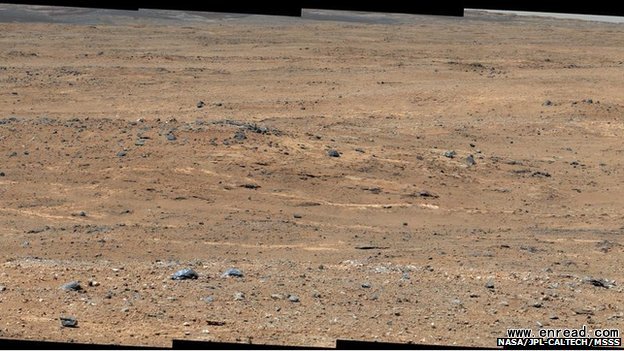| ||||||||||||||||||||||||||||||||||||||||||||||||||||||||||||||||
|
After two months of solid driving, the Curiosity Mars rover has finally parked for a few days of intense science.
经过两个月的一般行驶,好奇号火星探测车终于停下来进行几天的密集型探测。
 streaks1 in the lower-centre) on its approach to the waypoint" style="cursor:pointer" onclick="window.open('/upimg/allimg/130917/1_130917090426_1.jpg')" /> streaks1 in the lower-centre) on its approach to the waypoint" style="cursor:pointer" onclick="window.open('/upimg/allimg/130917/1_130917090426_1.jpg')" />Curiosity pictured Darwin (light streaks in the lower-centre) on its approach to the waypoint It will be studying the rocks under its wheels, trying to relate them to the outcrops seen earlier in the mission.
The Nasa robot will be using just its remote-sensing instruments. There is no expectation to drill.
Curiosity plans to make five such stop-overs as it pushes forward to the foothills of Mount Sharp, the big peak that dominates equatorial Gale2 Crater3.
Project scientist Prof John Grotzinger told BBC News the rover would be at its current location for "a few sols only". A sol is a Martian day, which is 39 minutes longer than an Earth day.
The first waypoint will give researchers an opportunity once more to examine conglomerate4, a rock type made up of small pebbles5 cemented together by finer material.
On Earth, this is a product of sediment6 transport in rivers, and indicates that water also flowed across the floor of Gale billions of years ago.
Curiosity has previously7 taken pictures of conglomerate as it rolled by the outcrops, but the stop-over is a chance to acquire much more detail.
"As you recall, we never got to analyse the conglomerate [earlier in the mission]. However, if you look at the most recent images, you'll see that we may finally get our chance - we have passed by several exposures of the conglomerate and now we're parked on it. It's looking very promising," said Prof Grotzinger.
点击  收听单词发音 收听单词发音
|
||||||||||||||||||||||||||||||||||||||||||||||||||||||||||||||||
- 发表评论
-
- 最新评论 进入详细评论页>>



